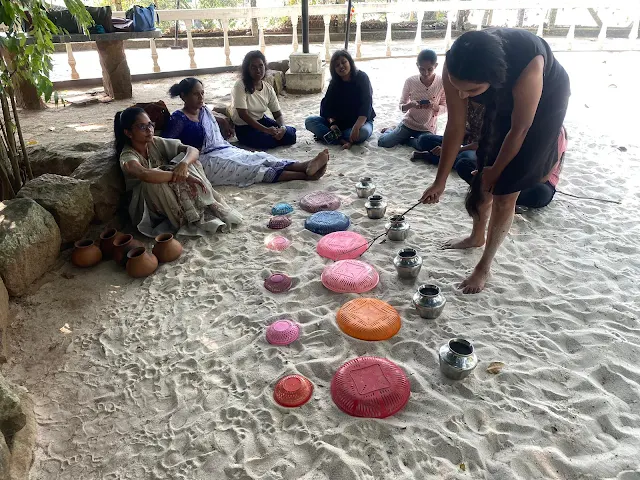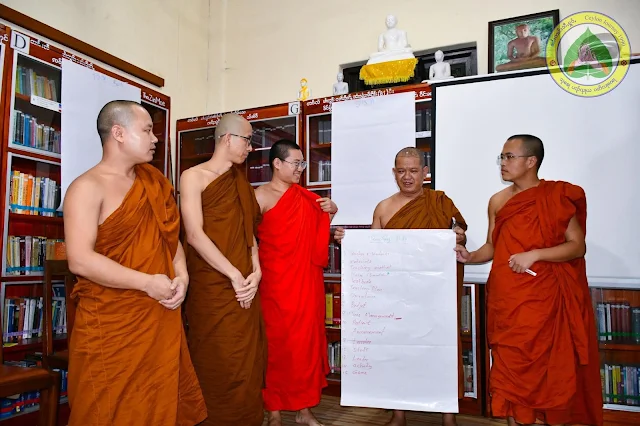
Try eating a very hot chili pepper. When you eat it, do you find the chili or do you find the spiciness? You find the spiciness, right? Now, regarding this nature of spiciness:
When someone who can't handle spicy food accidentally eats it, don't they spit it out? They do spit it out, right? When they spit it out, is it like spitting out chicken meat because it tastes good or bad? They spit it out because it's unpleasant to them.
For someone who enjoys spicy food, if they don't get to eat chilies, they feel unsatisfied with their meal. If they accidentally eat something spicy, don't they feel delighted? Don't they say "Now that's satisfying!"?
For those who can handle it, it's pleasant; for those who can't, it's unpleasant. Are these experiences the same? They're different for different people, aren't they? But if you have a hundred people from different races taste the spiciness, isn't the spiciness itself the same? Yes, it is.
That's the nature of spiciness. This spicy taste doesn't discriminate by saying "be good for you" or "be bad for you," does it? It's free from both good and bad judgments. That's the natural characteristic of spiciness. Isn't this worth contemplating?
Try eating very bitter Tama leaves (Neem Leave) When someone who doesn't like bitterness accidentally eats it, don't they spit it out? When they spit it out, is it because it's good or bad? Don't they say "Oh, the taste is completely ruined!"?
When someone who likes Tama leaves eats them, don't they say "Now this is delicious, now this is what I've been looking for"? Are these two people's experiences the same? The bitter taste doesn't favor anyone's face, does it? But isn't the bitterness itself identical? That's the natural characteristic.
The nature of bitterness is such that those who can eat it find it good, those who can't find it bad. This is happening in their minds, isn't it? Observe that mind carefully, understand? Isn't it taught that controlling the mind leads to happiness? These are the essential points, understand?
Examine all six sense doors in this way. When eating something sweet, it's just sweetness - those who like it find it good, those who don't find it bad. When eating something bitter, those who like it find it good, those who don't find it bad. Isn't this worth studying?
When examining the true nature of things, if you taste something sour, it's just sourness, right? When looking with eyes, there's just visible form. In that visible form, is there any inherent like or dislike? In sound, is there? In smell, is there? Think about it. In taste, is there? In the three types of touch sensations, is there? This is natural wisdom (bhāva ñāṇa). Note this - it's natural wisdom.
When looking back through this natural wisdom, these phenomena that arise - don't they cease? After arising, don't they pass away? Look in what has ceased - can you still find anything? The mind that's free from good and bad is also impermanent (anicca).
What we call extremely good is impermanent, what we call bad is impermanent. In other words, don't wealthy people die? Don't poor people die? Don't middle-class people die? Is death itself good or bad?
The wealthy can't escape aging, sickness, and death, right? What Noble Truth is this? (It's the Noble Truth of Suffering - Dukkha Sacca). Don't the poor die? Can they escape aging, sickness, and death? Don't the middle-class die? Can they escape aging, sickness, and death? In this regard, everyone is exactly the same. Isn't this worth contemplating?
Whatever phenomena arise, whether good or bad, isn't it taught that "Sabbe saṅkhārā aniccā" (all conditioned things are impermanent)? Good things end in impermanence, wealthy people end in impermanence, poor people end in impermanence, middle-class people end in impermanence.
The characteristic of impermanence is Dukkha Sacca, the characteristic of suffering is Dukkha Sacca, the characteristic of non-self is Dukkha Sacca. For those who understand the Four Noble Truths, isn't this taught as the Path knowledge, Fruition knowledge, and Nibbāna? Only with this wisdom will one reach the summit. Isn't this worth studying?
When we listen to Dhamma and then lose it, isn't it taught that we should search within ourselves to find the Dhamma? When you understand its true nature, that's what's correct. If you follow the duality of good and bad, can it be right? No, it can't, understand? It branches into two ways.
The spicy taste doesn't favor anyone's face, right? Neither does visible form. Their nature, isn't it worth studying through all six sense doors? Isn't it taught as arising and passing away?
Everything is taught as "Sabbe saṅkhārā aniccā." Whatever arises, you need to know it as "impermanence." Can this happen without Ñāta Pariññā (knowledge of the known)? Only with Ñāta Pariññā, distinguishing between concepts and ultimate realities, can wrong view be eliminated. Wrong view must first be eliminated through understanding, then through development.
Regarding development, when we turn to look at the aggregates, don't they change and decay? If they decay, are they permanent or impermanent? Is this impermanent nature pleasant or suffering? Is it happiness or suffering? Does this suffering have an owner? Does it follow beings' wishes? Does it conform to preferences? Isn't it taught as Anatta (non-self)?
When you see impermanence, do you see mind-matter (nāma-rūpa)? When you see suffering, do you see mind-matter? When you see non-self, do you see mind-matter? Don't you need to distinguish between impermanence and mind-matter? Between suffering and mind-matter? Between non-self and mind-matter? This is Tīraṇa Pariññā - knowledge through investigation.
When impermanence, suffering, and non-self come together, isn't it taught as arising and passing away? Which Noble Truth is this? (It's the Noble Truth of Suffering, Venerable Sir). Is it pleasant or suffering? Don't you need to know it as truly suffering? When truly known, doesn't the wrong view disappear? This is Yathābhūta Ñāṇa (knowledge of things as they really are).
In the second effort, don't you just see arising and passing away? Which Noble Truth? (It's the Noble Truth of Suffering, Venerable Sir). In the second stage, as wisdom matures, doesn't the mind want to be free from the aggregates, want to be liberated? Isn't this taught as Nibbindā Ñāṇa (knowledge of disenchantment)?
In the third effort, don't you just see arising and passing away? Search the whole body from foot to head - can you find even a needle-point of happiness? Is there no happiness because it exists or because it doesn't? If it doesn't exist, isn't it determined as complete suffering?
When this is determined, don't the three moral factors of the Path enter - Right Speech, Right Action, Right Livelihood? Combined with the five kinds of insight knowledge, don't they complete the Eight? When the Eight are complete, do you still see the five aggregates? Do you still see arising and passing away? Isn't this taught as Lokuttara (supramundane)?
Stream-entry Path and Fruition - isn't it worth examining what's eliminated? Wrong view, doubt, and latent defilements are eliminated. When these are eliminated, does mental action still arise? If mental action doesn't arise, do bodily and verbal actions still occur? If not, aren't the kamma leading to lower realms exhausted? Doesn't this end the cycle of lower realm existence? This is Pahāna Pariññā (knowledge of abandoning).
For one who attains these three kinds of knowledge - Ñāta Pariññā, Tīraṇa Pariññā, and Pahāna Pariññā - from beginningless saṃsāra, all old unwholesome kamma debts become ineffective. Can they still give results? Don't they all become Ahosi Kamma (ineffective kamma)? Strive to reach this stage.



















